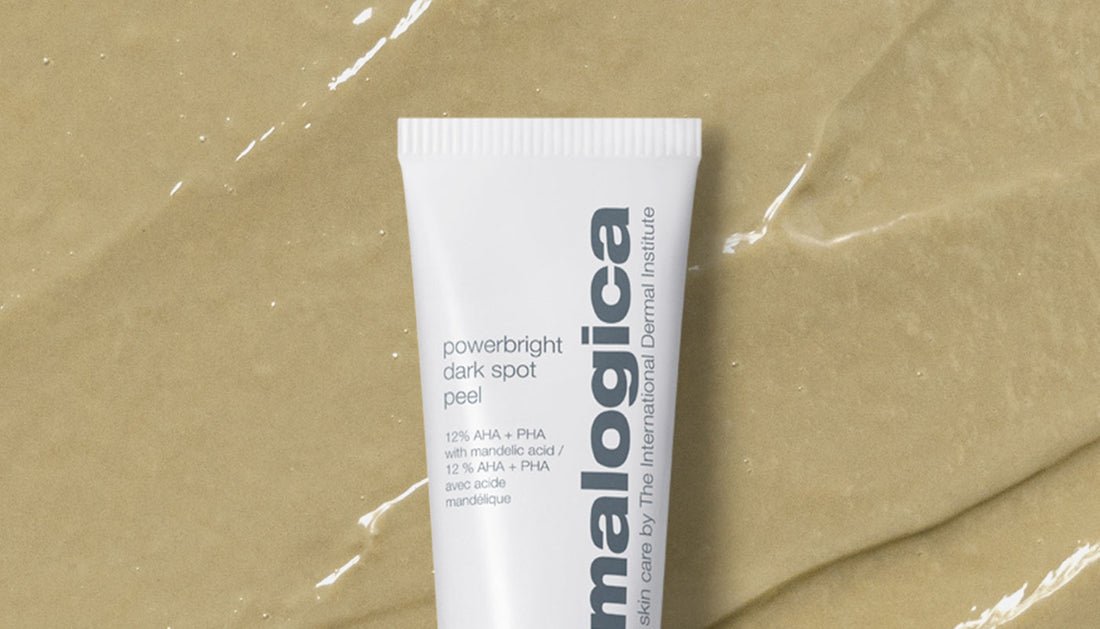One of the toughest skin conditions to treat is hyperpigmentation. With the various forms of skin darkening and uneven skin tone – sun spots, melasma, post-inflammatory hyperpigmentation - it can be tricky to know how to treat it safely and effectively. Pigmentation is also notoriously harder to treat on darker skin tones due to harsh actives and treatments potentially causing more harm than good, worsening pigmentation conditions. Whichever type of pigmentation you have and regardless of your skin colour, Dermalogica can help you safely achieve a brighter more even skin tone.
What causes hyperpigmentation and dark spots?
It helps to understand the science behind dark spots for a comprehensive approach to treating them. The official term for skin discolouration is hyperpigmentation. Unlike freckles, hyperpigmentation doesn’t fade in winter and, unfortunately, it becomes more visible as we age. The most common causes of hyperpigmentation are:
- Sun exposure: When your skin is repeatedly exposed to UV light, sun damage occurs. Brown spots and uneven skin tone develop as a result of too much melanin being produced to help protect your skin from UV light. Daily SPF is critical when treating pigmentation concerns.
- Pollution: New research indicates that airborne pollution particles that become lodged deep in the skin, oxidises the surrounding tissue causing irritation that leads to uneven pigmentation. Rising levels of airborne soot and traffic-generated pollution cause a 20-25% increase in dark spots – adding up to 20 years to your perceived age! Thorough cleansing and inclusion of antioxidants assist with pigmentation treatment.
- Hormones: Melasma is hormone-related hyperpigmentation caused by increased hormone stimulation. It’s most commonly experienced by women who are pregnant (which is why it’s also known as the “mask of pregnancy”) or taking contraceptives but can also be a reaction to cosmetics or medications. When hormones are driving hyperpigmentation, results may be slower until hormones are balanced.
- Post-Inflammatory Hyperpigmentation: This type of dark spot is the result of inflammation or injury to the skin (for example, from acne, deep cuts or burns). Susceptibility to PIH typically increases with age, as cell turnover slows with age, and it takes dark spots longer to move to skin’s surface and slough off. Avoiding skin irritation and sensitivity is an important strategy when treating pigmentation concerns.
How does exfoliation help with hyperpigmentation?
Exfoliating the skin helps lift hyperpigmented cells off the skin’s surface quicker, revealing a fresher brighter skin. However, when it comes to certain forms of hyperpigmentation, a regular exfoliation product probably won’t deliver the results you’re looking for. You might think a stronger acid-based peel will deliver better results, but we must be cautious when treating hyperpigmentation, especially on darker skin tones as sensitising the skin triggers melanogenesis – the process of skin pigment production. Aggressively treating hyperpigmentation can result in more pigment production due to the skin’s natural wound healing process and the part that skin pigment plays in this. When choosing an exfoliant for hyperpigmentation, look for formulas specifically designed to fade it whilst protecting skin’s barrier and actively reducing triggers that lead to post-inflammatory hyperpigmentation.
PowerBright Dark Spot Peel – visibly lifts surface pigmentation on all skin tones.
We are excited to bring you a new product from Dermalogica, PowerBright Dark Spot Peel. If you’re looking to visibly lift surface hyperpigmentation safely and effectively, this is a must have for you!
PowerBright Dark Spot Peel is an at-home peel to visibly lift surface hyperpigmentation, including UV-induced dark spots, post-breakout marks and melasma. It’s clinically proven to lift dark spots in 5 uses*. The peel can be used for 5 consecutive days to kick start results then used 2-3 x week.
This peel is suitable for all skin types and tones unlike many aggressive peels on the market and actually helps reduce the triggers of post-inflammatory hyperpigmentation. Skin feels smooth, soft and looks brighter and more even after just 15 minutes.
*Independent clinical results with 33 volunteers, 8 weeks.

PowerBright Dark Spot Peel - ingredients that deliver brightening results
Inspired by professional peels, this fast-acting at-home peel formula contains an AHA+PHA blend including Mandelic Acid to help quickly exfoliate away the appearance of stubborn hyperpigmentation. A barrier-restoring Omega-3 blend derived from algae soothes and helps reduce triggers that lead to post-inflammatory hyperpigmentation. Brightening Tranexamic Acid and Niacinamide help even skin tone. Plus, a nourishing, antioxidant-rich Turmeric Butter Blend leaves skin feeling smoother and softer.
Regimen essentials for the treatment and management of hyperpigmentation
Follow Dermalogica’s simple Prep, Treat and Glow regimen steps with formulas designed to fade dark spots and help prevent future ones whilst boosting skin’s natural luminosity.
PREP After double cleansing, apply PowerBright Dark Spot Peel, starting with 5 consecutive days, then use 2-3 x week to maintain results.
TREAT PowerBright Dark Spot Serum supports skin defence from pollution, fades dark spots and boosts skins radiance. Apply at least 1 x day under moisturiser.
GLOW Apply PowerBright Moisturiser SPF50 AM and PowerBright Overnight Cream PM for round the clock hydration and dark spot fading plus critical defence against UV-induced pigmentation.
Professional treatments for hyperpigmentation
For advanced results on stubborn hyperpigmentation concerns, contact your nearest Dermalogica Skin Therapist offering MelanoPro Peel System - a clinical-strength peel program that delivers visible results in less than 6 weeks!
Find your nearest Dermalogica Expert here or chat with our skin therapists online for personalised advice today.




